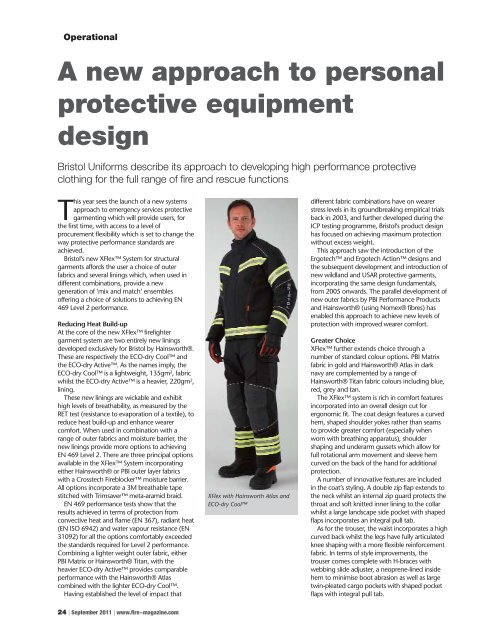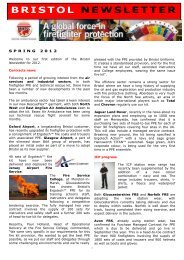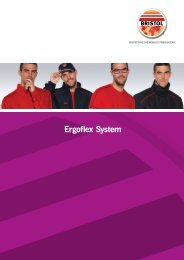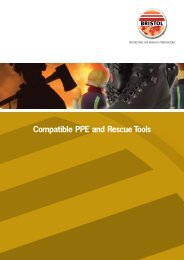pdf 1 - Bristol Uniforms
pdf 1 - Bristol Uniforms
pdf 1 - Bristol Uniforms
Create successful ePaper yourself
Turn your PDF publications into a flip-book with our unique Google optimized e-Paper software.
Operational<br />
A new approach to personal<br />
protective equipment<br />
design<br />
<strong>Bristol</strong> <strong>Uniforms</strong> describe its approach to developing high performance protective<br />
clothing for the full range of fire and rescue functions<br />
This year sees the launch of a new systems<br />
approach to emergency services protective<br />
garmenting which will provide users, for<br />
the first time, with access to a level of<br />
procurement flexibility which is set to change the<br />
way protective performance standards are<br />
achieved.<br />
<strong>Bristol</strong>’s new XFlex System for structural<br />
garments affords the user a choice of outer<br />
fabrics and several linings which, when used in<br />
different combinations, provide a new<br />
generation of ‘mix and match’ ensembles<br />
offering a choice of solutions to achieving EN<br />
469 Level 2 performance.<br />
Reducing Heat Build-up<br />
At the core of the new XFlex firefighter<br />
garment system are two entirely new linings<br />
developed exclusively for <strong>Bristol</strong> by Hainsworth®.<br />
These are respectively the ECO-dry Cool and<br />
the ECO-dry Active. As the names imply, the<br />
ECO-dry Cool is a lightweight, 135gm 2 , fabric<br />
whilst the ECO-dry Active is a heavier, 220gm 2 ,<br />
lining.<br />
These new linings are wickable and exhibit<br />
high levels of breathability, as measured by the<br />
RET test (resistance to evaporation of a textile), to<br />
reduce heat build-up and enhance wearer<br />
comfort. When used in combination with a<br />
range of outer fabrics and moisture barrier, the<br />
new linings provide more options to achieving<br />
EN 469 Level 2. There are three principal options<br />
available in the XFlex System incorporating<br />
either Hainsworth® or PBI outer layer fabrics<br />
with a Crosstech Fireblocker moisture barrier.<br />
All options incorporate a 3M breathable tape<br />
stitched with Trimsaver meta-aramid braid.<br />
EN 469 performance tests show that the<br />
results achieved in terms of protection from<br />
convective heat and flame (EN 367), radiant heat<br />
(EN ISO 6942) and water vapour resistance (EN<br />
31092) for all the options comfortably exceeded<br />
the standards required for Level 2 performance.<br />
Combining a lighter weight outer fabric, either<br />
PBI Matrix or Hainsworth® Titan, with the<br />
heavier ECO-dry Active provides comparable<br />
performance with the Hainsworth® Atlas<br />
combined with the lighter ECO-dry Cool.<br />
Having established the level of impact that<br />
XFlex with Hainsworth Atlas and<br />
ECO-dry Cool<br />
different fabric combinations have on wearer<br />
stress levels in its groundbreaking empirical trials<br />
back in 2003, and further developed during the<br />
ICP testing programme, <strong>Bristol</strong>’s product design<br />
has focused on achieving maximum protection<br />
without excess weight.<br />
This approach saw the introduction of the<br />
Ergotech and Ergotech Action designs and<br />
the subsequent development and introduction of<br />
new wildland and USAR protective garments,<br />
incorporating the same design fundamentals,<br />
from 2005 onwards. The parallel development of<br />
new outer fabrics by PBI Performance Products<br />
and Hainsworth® (using Nomex® fibres) has<br />
enabled this approach to achieve new levels of<br />
protection with improved wearer comfort.<br />
Greater Choice<br />
XFlex further extends choice through a<br />
number of standard colour options. PBI Matrix<br />
fabric in gold and Hainsworth® Atlas in dark<br />
navy are complemented by a range of<br />
Hainsworth® Titan fabric colours including blue,<br />
red, grey and tan.<br />
The XFlex system is rich in comfort features<br />
incorporated into an overall design cut for<br />
ergonomic fit. The coat design features a curved<br />
hem, shaped shoulder yokes rather than seams<br />
to provide greater comfort (especially when<br />
worn with breathing apparatus), shoulder<br />
shaping and underarm gussets which allow for<br />
full rotational arm movement and sleeve hem<br />
curved on the back of the hand for additional<br />
protection.<br />
A number of innovative features are included<br />
in the coat’s styling. A double zip flap extends to<br />
the neck whilst an internal zip guard protects the<br />
throat and soft knitted inner lining to the collar<br />
whilst a large landscape side pocket with shaped<br />
flaps incorporates an integral pull tab.<br />
As for the trouser, the waist incorporates a high<br />
curved back whilst the legs have fully articulated<br />
knee shaping with a more flexible reinforcement<br />
fabric. In terms of style improvements, the<br />
trouser comes complete with H-braces with<br />
webbing slide adjuster, a neoprene-lined inside<br />
hem to minimise boot abrasion as well as large<br />
twin-pleated cargo pockets with shaped pocket<br />
flaps with integral pull tab.<br />
24 | September 2011 | www.fire-magazine.com
Operational<br />
<strong>Bristol</strong> Uniform’s range of garments: XFlex with PBI Matrix and ECO-dry Active, XFlex with Hainsworth Titan and ECO-dry Active, XFlex with PBI<br />
Matrix and ECO-dry Active<br />
As with other <strong>Bristol</strong> structural PPE offerings, a<br />
total of 28 male and female sizes are available as<br />
standard with seven chest and four height<br />
fittings.<br />
The XFlex System is being introduced to<br />
complement <strong>Bristol</strong>’s existing range of structural<br />
garments, including the Ergotech range, and<br />
will be followed during the next few months by<br />
a number of other new products for technical<br />
rescue and marine firefighting activities.<br />
Continuous Research and Development<br />
High performance protective clothing, designed<br />
to ensure the safety of frontline emergency<br />
service workers as well as many others in<br />
hazardous occupations, results from bringing<br />
together a number of key elements to achieve<br />
innovation. These essential ingredients, founded<br />
on a long-term strategy of investment in change,<br />
include an ongoing research and development<br />
programme, a continuous search for<br />
improvements in fibres and fabrics, the<br />
development and maintenance of collaborative<br />
relationships with suppliers and a commitment<br />
to embrace new technology.<br />
In the field of emergency services PPE, and<br />
especially in firefighter clothing, <strong>Bristol</strong> has<br />
become a leading designer and manufacturer<br />
since a major review of its business in the late<br />
1990s saw the emergence of a new corporate<br />
strategy. Its long term investment plans, aimed<br />
clearly at firmly establishing itself as a leading<br />
global supplier, have repositioned <strong>Bristol</strong> as an<br />
innovative company capable of designing<br />
leading edge garments through a process of<br />
“In the field of<br />
emergency services<br />
PPE, and especially<br />
in firefighter clothing,<br />
<strong>Bristol</strong> has become<br />
a leading designer<br />
and manufacturer”<br />
continuous R&D.<br />
Revised Technical Standards in the Pipeline<br />
Following a period, since 2005, during which<br />
time there has been relatively little change in<br />
European firefighter garment standards, this is<br />
about to change as several new standards are<br />
being developed and introduced by 2013. The<br />
first to come into effect will be the new European<br />
marine standard in December 2011 when,<br />
depending on the composition, marine<br />
firefighting garments will be required to meet EN<br />
1486 or EN 469 or ISO 15538.<br />
For structural garments, EN 469 (2005) is<br />
currently under review and a revised standard is<br />
also expected to emerge by 2013. EN ISO 11612<br />
(2008) is the protection against general flame<br />
standard. This has also started the revision<br />
process and a new version is likely to come into<br />
effect by 2013/14. In the meantime, a<br />
completely new standard for USAR PPE is being<br />
proposed and initial drafting is underway.<br />
Product Improvement Programme<br />
<strong>Bristol</strong> is committed to a programme of ongoing<br />
product development and improvement as part<br />
of its policy of helping to pioneer changes in<br />
firefighter PPE aimed at staying at the forefront of<br />
standards compliance. Pursuing a product<br />
strategy, in which design is focused on<br />
developing specific products for different uses,<br />
has seen the introduction of bespoke designs for<br />
wildland and technical rescue over the last five<br />
years and will see the launch of new USAR and<br />
marine firefighting garments later in 2011.<br />
www.fire-magazine.com | September 2011 | 25






